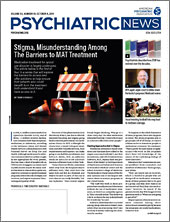In 2018, 4.2 million Americans had an opioid use disorder (OUD), and of those, 1.2 million received medication treatment with buprenorphine, methadone, or naltrexone, according to the Substance Abuse and Mental Health Services Administration’s 2018 National Survey on Drug Use and Health. Although medication for addiction treatment (MAT) is neither sought by nor appropriate for every patient, that less than a third of people with an OUD receive it suggests an unmet need in public health despite the many studies that show it reduces illicit opioid use, improves retention in opioid treatment programs, lowers the risk of relapse and overdose, and improves patients’ functioning and quality of life.
The roots of this phenomenon lie in the history of MAT, one that is rife with misunderstanding and stigma going back to the first government-run methadone clinics in 1972. Although the clinics were created with good intentions and offer valuable services, their requirements and logistics can make going to one feel like punishment, said Edwin A. Salsitz, M.D., an addiction medicine specialist at the Addiction Institute of Mount Sinai in New York.
“Some clinics are blocks, sometimes miles away from the hospitals they’re affiliated with. They don’t have the same look and feel as a hospital, and they’re located in parts of the city or town that are not really desirable,” Salsitz explained. “That created stigma. People began thinking, ‘Why go to a clinic every day? No other medication is handled that way. I want to be treated in a doctor’s office like other people.’”
Clashing Approaches Add to Stigma
Traditional abstinence-based treatment and therapies have added to the stigma associated with MAT, and thus its underuse, said APA President Bruce Schwartz, M.D., deputy chair and professor of psychiatry in the Department of Psychiatry and Behavioral Sciences at Montefiore Medical Center and the Albert Einstein College of Medicine. The Montefiore Department of Psychiatry operates one of the largest substance use treatment programs in the United States.
“The staff who work in those programs have usually attained abstinence without the use of medication treatment, so there’s an antipathy against it. Their attitude is that ‘This is the way I did it, so this is the way it should work for everybody,” he said.
Schwartz added that there is a belief among many abstinence-based counselors that incorporating MAT into recovery is merely replacing one addiction with another.
“It happens in the rehab dimension of these programs, but it also happens in detox. The detox programs aim to get people off of all drugs, so there’s a disincentive to transition people to medication treatment,” he continued. “That’s partly because many nonphysicians who work in the programs don’t have full knowledge of the nature of the underlying biology of these disorders.”
Patients on MAT sometimes encounter pushback from counselors and members of abstinence-based groups, said Salsitz.
“They say you’re not in recovery, which is hurtful to people who are doing well on medication treatment. Many of these patients like to be part of a group, and they don’t want to lie and not [reveal that] they take medications.” However, he noted, if the patients do tell, they’ll be badgered with questions such as “When are you going to get off it?”
Misperceptions of medication treatment continue among abstinence-based counselors partly because the programs are undermedicalized, Schwartz said.
“The physician comes in once a week or once a day for a couple of hours, so for many drug treatment programs, [recovery] has been the province of those who are abstinence based,” he said. “[Physicians] should help educate staff about the advantages of medication treatment. There has to be some medical supervision as to what is the most appropriate treatment.”
Another reason misperceptions persist is that historically, opioid use disorders did not figure prominently in treatment programs the way alcohol and other drugs have, said John F. Kelly, Ph.D., director of the Massachusetts General Hospital Recovery Research Institute in Boston.
“Now with the opioid epidemic of the last 10 or 15 years, OUDs have been thrust into the forefront. There has been a shift in how we approach substance use disorders [SUDs], and that’s where there has been a culture clash with medications becoming a major player,” Kelly said.
Stigma Among Health Professionals
The culture clash has reared its head within the medical profession as well. Interviews with 47 addiction-treatment professionals summarized in Social Science & Medicine suggest that physicians who provide MAT may be subjected to stigma themselves, not only from nonphysician counselors in abstinence-based programs, but also from other physicians. This can occur because other physicians have outdated knowledge about MAT, believe that MAT is substituting one addiction for another, or advocate abstinence.
Such attitudes may take hold in medical training, where MAT is often passed over on rounds and medical students are not exposed to success stories involving patients who use MAT, said Salsitz. “For many medical students, a large part of their education takes place in large urban hospitals, where the methadone patients are admitted if they’re not doing well. If that’s all you see, that’s what you expect.”
Kelly agreed, noting that most of the stigma is directed toward people who use methadone.
“There’s a sense of people just being left to languish on methadone in the parking lot of life, where they don’t do anything and don’t seem to go anywhere. It’s a cultural stereotype in the treatment sector,” Kelly said, adding that buprenorphine has not been stereotyped this way.
Salsitz said that the way the medical community treats its own members who have OUDs exacerbates the problem.
“State-run Physician Health Programs generally will not allow physicians with an OUD to be treated with methadone maintenance, although some programs now allow the use of buprenorphine maintenance,” Salsitz said. “Traditionally, Physician Health Programs have endorsed naltrexone for treating physicians with an OUD. Until recently the paradox has been that physicians were not allowed to be on opioid agonist therapy despite the evidence of its effectiveness.”
Education Counters Stigma
Stigma presents a hurdle in providing MAT to patients with OUD, but it can be overcome with a willingness to listen and educate others, said Kelly. He suggests motivational interviewing and similar approaches when encountering resistance from counselors, physicians, patients, and others who may have misconceptions about MAT.
“We need to understand why they may have those beliefs and attitudes and see the world through their eyes. Where are they coming from?” Kelly said. “Listen, acknowledge, and validate why they might have those beliefs. Then show them the evidence, what the medications do, and how they reduce overdose and increase the chances of remission. We have a lot of data that support medication treatment.
“The more understanding people have about addiction and the science of the medication, the more they start to see how medication can help,” Kelly added. “I liken medication treatment to nicotine patches for smoking. It takes away the nagging cravings of the addiction, so you can focus on your behavior and lifestyle changes to make them more conducive to sustaining long-term remission.”
Because family members may be a source of misinformation or stigma, Sarah M. Bagley, M.D., medical director at Boston Medical Center’s Center for Addiction Treatment for Adolescents/Young Adults Who Use Substances, engages them in the process. Last year, Bagley and her colleagues published a case series in Addiction Science & Clinical Practice about stigma associated with MAT for young adults with OUDs.
“We invite families to come visit. We ask them to have a family meeting to listen to their concerns, and then share with them why medication treatment is the recommended approach,” Bagley said.
She tells patients and family members that OUD is no different from other medical illnesses, such as diabetes, for which study after study shows there are effective treatments.
“If I didn’t offer medication treatment, I would not be doing my job,” she said.
To that end, Schwartz encourages all psychiatrists to be prepared to offer every available option to their patients who have OUD, including MAT.
“The reality is that you need everything,” he said. “It’s not one size fits all. It depends on the patient’s history and how well the patient has done in terms of attempting recovery from their SUD.” He emphasized that no one in practice should shy away from treating people with OUD or other SUDs, and he encourages all psychiatrists to become qualified to prescribe buprenorphine.
“We have medications that are helpful in the care of these patients,” Schwartz said. “It’s not a magic pill, but these patients are very treatable.” ■
“2018 NSDUH Annual National Report” is posted
here. “Intervention Stigma: How Medication-Assisted Treatment Marginalizes Patients and Providers” is posted
here. “Stigma Associated With Medication Treatment for Young Adults With Opioid Use Disorder: A Case Series” is posted
here.


